Abstract
Objective:
The objective of the following study is to determine the use of ultrasound as an important adjunct to clinical and laboratory profile in diagnosing dengue fever and in predicting the severity of the disease by correlating imaging features with platelet count. The variation in sonographic features seen in patients from different age groups was also studied.
Materials and Methods:
This is a retrospective study. 96 patients who were serologically diagnosed as having dengue fever between April and August 2012 were referred for ultrasound scanning of the abdomen and thorax and the imaging findings were analyzed.
Results:
Out of 96 sero-positive dengue cases, 64 (66.7%) patients showed edematous gallbladder (GB) wall thickening, 62 (64.5%) patients showed ascites, 48 (50%) patients had pleural effusion, 17 (17.7%) patients had hepatomegaly, 16 (16.7%) patients had splenomegaly and in 17 (17.7%) patients ultrasound findings were normal. Edematous GB wall thickening, ascites and pleural effusion were the most common combination of findings in all age groups. Edematous GB wall thickening was seen in 97.8% of patients with platelet count of less than 40,000 along with ascites (86.9%) and pleural effusion (58.6%). In patients with platelet count between 40,000 and 80,000 ascites was more common than edematous GB wall thickening. Significantly no abnormal sonographic finding was detected in patient with platelet count more than 150,000.
Conclusion:
Sonographic features of thickened GB wall, pleural effusion (bilateral or right side), ascites, hepatomegaly and splenomegaly should strongly favor the diagnosis of dengue fever in patients presenting with fever and associated symptoms, particularly during an epidemic. The degree of thrombocytopenia showed a significant direct relationship to abnormal ultrasound features.
Keywords: Ascites, dengue fever, hepatomegaly, edematous gallbladder wall thickening, pleural effusion, splenomegaly, thrombocytopenia, ultrasound features
INTRODUCTION

Prashant G Patil
One of the common causes of fever in the tropics is dengue virus, a flavi virus. In 2008, South-east Asia and Western Pacific accounted for 70% of the global burden of dengue fever. The countries with a high incidence are Indonesia, Thailand, Myanmar, Sri Lanka, Bangladesh and India.[1] Dengue is transmitted by mosquito Aedes aegypti, widely distributed throughout tropical and sub-tropical areas of the world. There are four known serotypes of dengue, but severe form of dengue fever is caused by infection by more than one serotype.[2] Clinically dengue manifests with sudden onset of high fever with chills, intense headache, muscle and joint pain, retro-orbital pain and severe backache. Fever usually lasts for about 5 days, rarely for more than 7 days.[3] Hemorrhagic diathesis and thrombocytopenia with concurrent hemoconcentration are a constant finding.
In mid-2012, there was an outbreak of dengue in Bengaluru, India. The purpose of this retrospective study was to examine the imaging features of the abdomen and thorax in patients suffering from dengue fever, identify if ultrasound can become an important adjunct to clinical and laboratory profile in diagnosing dengue fever and to correlate these finding with platelet counts and the severity of the disease across different age groups.
MATERIALS AND METHODS
The study was done in our tertiary care center. Our institutional review board approved this retrospective study and informed consent was not required. Ninety-six patients who were serologically diagnosed as having dengue fever between April and August 2012 were referred for ultrasound scanning of the abdomen and thorax and the findings were analyzed.
All ultrasound examinations were performed with an ultrasound machine (GE Voluson 730 Pro model) using 3.5 MHz and 5 MHz probes. Gallbladder (GB) wall thickening, which was the consistent finding in serologically positive cases, was measured by placing the callipers between the two layers of the anterior wall. Thoracic scanning was done in either sitting or supine posture. Both the pleural spaces were evaluated through an intercostal approach. Liver measuring more than 15 cm was taken as hepatomegaly and spleen measuring more than 12 cm was taken as splenomegaly.[4]
The serological tests for dengue including non-structural protein-1 (NS-1) Ag test and dengue immunoglobulin G/immunoglobulin M test were performed to confirm the diagnosis. NS-1, undergoes least antigenic variation and is a glycoprotein present in high concentration in the serum of dengue infected patients.
Sonography was performed by radiologists having a minimum of 5 years experience in abdominal sonograghy. Scanning was performed only once so there is no inter-observer variation.
Rationality for sample size
According to a study carried out by Joshi et al.,[5] 66% of the patients are likely to have pleural effusion on ultrasound examination. Based on this finding with absolute precision of +10 or −10 and with a probability level of P ≤ 0.05, it was established that nearly 90 patients were required to be included in the study to achieve statistical validation.
Statistical analysis of data
Qualitative variables such as the presence of various ultrasound features were expressed as percentages. Association of various sonographic features with different age groups or platelet count was assessed through Chi-square test of statistical significance. P ≤ 0.05 was considered for statistical significance.
A total of 96 serologically positive patients were further divided into four age groups to determine the age distribution of imaging features in dengue fever. Group 1 consisted of patients from 0 to 9 years (16), Group 2 had patients from 10 to 19 years of age (17), Group 3 consisted of patients from 20 to 39 years of age (43) and Group 4 patients were more than 40 years of age (20).
RESULTS
Out of the 96 patients, 64 had GB wall thickening (66.7%) [Figures 1 and 2], 62 had ascites (64.5%) [Figure 3], 25 had bilateral pleural effusion (26%), 22 had only right pleural effusion (22.9%) [Figure 4], 1 patient had only left pleural effusion, 17 had hepatomegaly (17.7%), 16 had splenomegaly (16.7%) and 17 had no abnormal ultrasound findings (17.7%) [Table 1].
Figure 1.
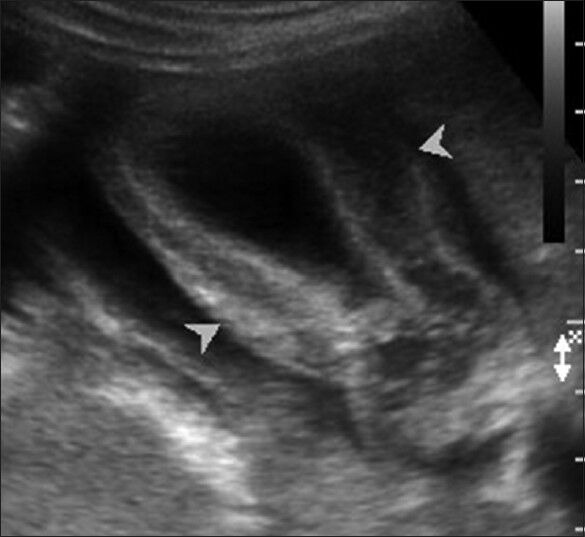
32-year-old male patient with a history of fever with thrombocytopenia, diagnosed with dengue fever. Ultrasound scan of the abdomen shows thickened edematous gallbladder wall.
Figure 2.
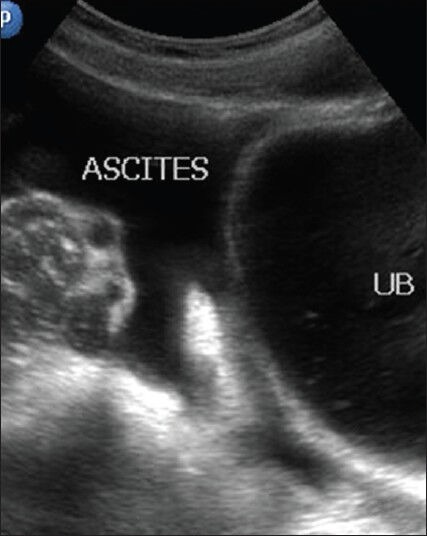
24-year-old male patient with a history of fever diagnosed with dengue fever Ultrasound scan shows moderate free fluid in the peritoneal cavity surrounding urinary bladder and gallbladder wall thickening and pleural effusion. Later serology confirmed diagnosis of dengue.
Figure 3.
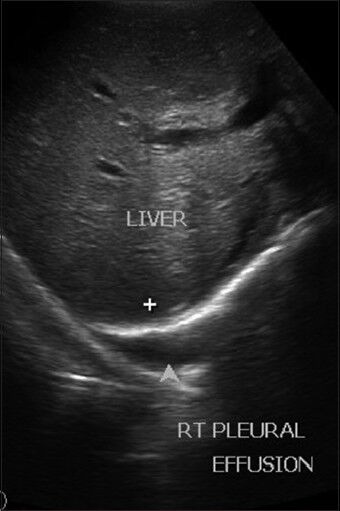
28-year-old female patient with a history of fever with thrombocytopenia, diagnosed with dengue fever. Ultrasound shows minimal right-sided pleural effusion.
Figure 4.
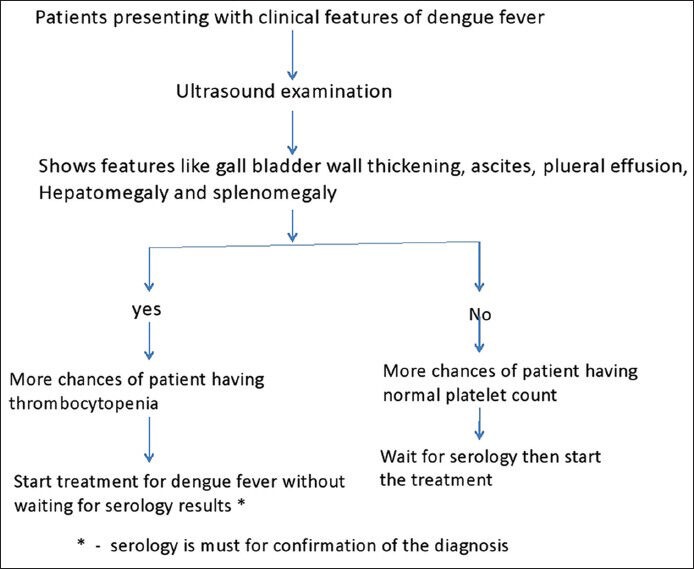
Algorithm.
Table 1.
Incidence of different sonographic findings in dengue fever
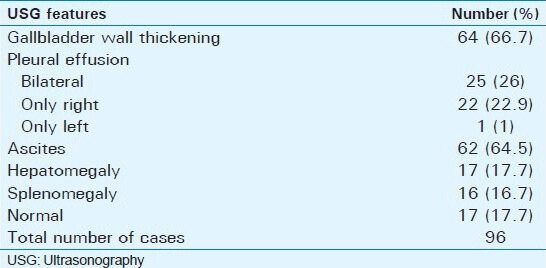
The important findings regarding age distribution of imaging features are as follows:
In our stud, dengue fever was most commonly seen in the age group of 20-39 years (44.8%)
GB wall thickening was more common in Group 1 and Group 4 (75%) than in other age groups where as ascites most commonly seen in the age group of 0-9 years (75%) than in other age groups
GB wall thickening (75%) was more common than ascites (50%) in the age group >40 years
However, the ultrasound features like GB wall thickening (P = 0.701), pleural effusion (P = 0.08), ascites (P = 0.41), hepatomegaly (P = 0.11) and splenomegaly (P = 0.11) did not reveal any statistical significance [Table 2 and Graph 1].
Table 2.
Incidence of sonographic findings in relation to different age groups

Graph 1.
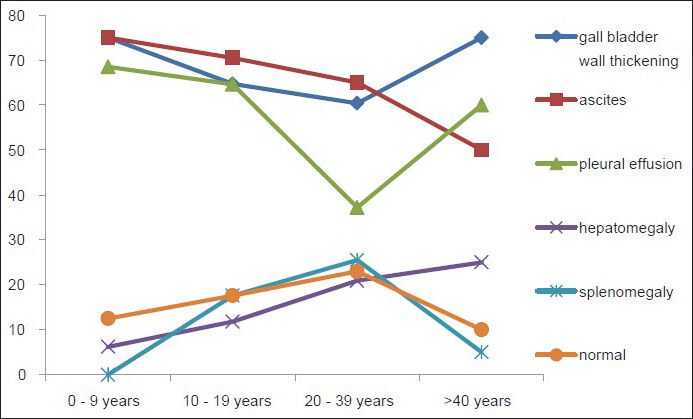
Graphical representation of ultrasound findings among different age groups. x-axis shows % of patients showing different features on ultrasound, y-axis shows patient age group.
The combination of imaging features observed among the groups was as follows:
GB wall thickening, ascites and pleural eff usion were commonly associated with dengue fever in all age groups
Splenomegaly and hepatomegaly were seen commonly in the age groups 10-19 years and 20-39 years, respectively [Table 3].
Table 3.
Combination of sonographic findings seen in different age groups
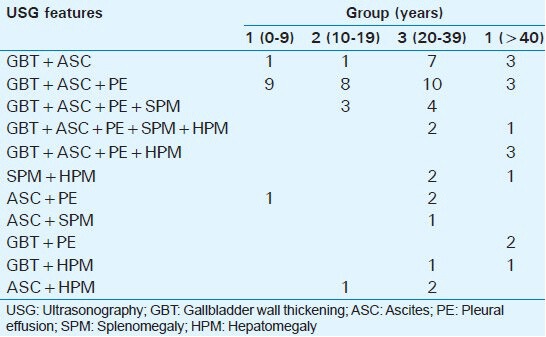
Correlation of imaging features with platelet count
GB wall thickening was seen in most of patients whose platelet count was less than 40,000 (97.8%) and more frequently seen in patients whose platelet count was less than 80,000 (87%).
Ascites (86.9%) and pleural effusion (68.6%) were the other common findings seen in patients whose platelet count was less than 40,000.
In patients whose platelet count was 40,000-80,000, ascites was more common than GB wall thickening.
Out of 16 splenomegaly cases, 11 were seen in patients whose platelet count was less than 40,000.
In five patients whose platelet count was more than 150,000, no abnormal ultrasound findings were detected.
Decrease in platelet count, (40,000) was associated with the presence of various ultrasound features such as GB wall thickening (P < 0.001), pleural effusion (P < 0.001), ascites (P < 0.001) and splenomegaly (P < 0.024). The correlations being statistically significant [Table 4 and Graph 2].
Table 4.
Correlation of sonographic findings with platelet count

Graph 2.
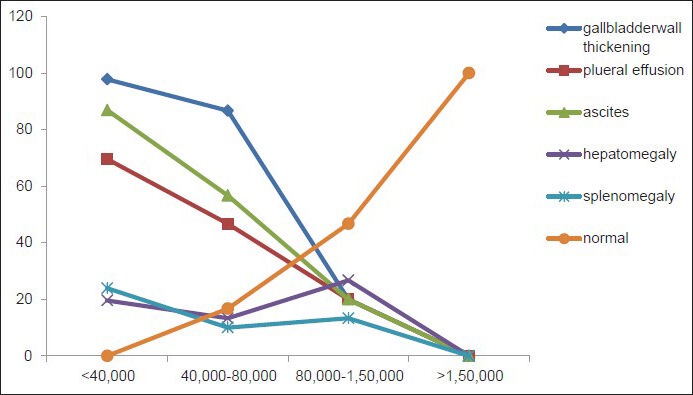
Graphical representation of sonographic findings in patients with different platelet count. x-axis shows % of patients showing different features on ultrasound, y-axis show platelet count.
DISCUSSION
Of all the arthropod-borne viral diseases, dengue fever is the most common. Dengue fever is one of the most important emerging diseases of tropical and sub-tropical areas. In a pandemic in 1998, 1.2 million cases of dengue fever and dengue hemorrhagic fever (DHF) were reported from 56 countries. It is estimated that each year, 50 million people world-wide get infected, with 500,000 cases of DHF and at least 12,000 deaths get infected.[6]
In India, the risk of dengue fever has increased in recent years due to rapid urbanization, life-style changes and poor water management. Poor water management is often coupled with lack of awareness in the general public about the breeding of mosquitoes and protection from their bites.[7] During 2011-12, dengue was endemic in 23 states.[8] In 2008, a total of 12,561 cases and 80 deaths were reported. In 2009, about 15,509 cases and 89 deaths were reported. In 2010, 28,292 cases and 110 deaths were reported. In 2011, 17,273 cases and 112 deaths were reported.[9]
Dengue fever starts during the rainy season when breeding of vector mosquitoes is generally abundant. Dengue cases are more during September to November in the post-monsoon season.[10] Classical dengue fever clinically manifests with sudden onset of high fever with chills, intense headache, muscle and joint pain, retro-orbital pain and severe backache. Fever usually lasts for about 5 days and rarely for more than 7 days. Severe form of dengue fever is caused by infection with more than one serotype because the first infection probably sensitizes the patient while the second infection with a different serotype appears to produce an immunological catastrophe.[11] Early detection of DHF/dengue shock syndrome (DSS) can go a long way in managing these patients and reducing morbidity and mortality, especially in DHF and DSS cases.[12]
Serology is the mainstay in the diagnosis of dengue fever. Hemagglutination inhibition antibodies usually appear at detectable levels by day 5-6 of febrile illness. Ultrasound findings in early, milder form of dengue fever include GB wall thickening, minimal ascites, pleural effusion and hepato-splenomegaly. Severe forms of the disease are associated with the collection of fluid in the perirenal and pararenal regions, hepatic and splenic subcapsular fluid, pericardial effusion, pancreatic enlargement and hepato-splenomegaly. Due to intraparenchymal and subcapsular hemorrhages, there will be an alteration in the normal liver echo texture.[5,13] However, in our study, we did not find any of the above-mentioned sonographic features even in severe forms of dengue fever except hepatosplenomegaly.
GB wall thickening also occurs in association with other conditions such as ascites, hypoalbuminemia, congestive cholecystopathy and in patients with cirrhosis of liver and portal hypertension. It is a very non-specific finding when considered in isolation and is therefore a major limitation of this study.
Imaging features of dengue fever such as GB wall thickening, ascites, pleural effusion, hepatomegaly and splenomegaly are reasonably accurate in the diagnosis of dengue fever. This helps in starting appropriate management of the patient as soon as ultrasound is done, especially in centers where high end laboratory facilities may not be available for serological confirmation. While serological tests are confirmatory in the diagnosis of dengue fever, ultrasound can be of value in the assessment of severity.
In a similar study conducted during the epidemic in 1997 by Joshi et al., the most common age group affected was 20-40 years and right-sided pleural effusion was the most common finding, like in our study [Table 2] In their study, the most common finding was pleural effusion (66%); but in our study, it was edematous GB wall thickening (66.7%). In their study, ascites was seen in only 50% of cases; but in our study, it was seen in 64.5%, being the second most common finding. In our study on 96 patients, pleural effusion was seen in 60% of cases. This is probably indicative of a gradual change in the sonographic profile of dengue fever in our country.
The severity of the course of the disease, which is directly linked to the platelet count, can also be assessed by sonography. If a patient shows all ultrasound features associated with dengue fever it indicates the platelet count is likely to be less than 40,000 and the patient may require blood transfusion. This allows the treating physician to arrange for blood after an ultrasound exam before platelet count values are available. The relationship of sonographic findings across age groups is also established in this study.
CONCLUSION
Sonographic features of thickened GB wall, pleural effusion (bilateral or right side), ascites, hepatomegaly and splenomegaly should strongly favor the diagnosis of dengue fever in patients presenting with fever and associated symptoms, particularly during an epidemic. A simple ultrasound examination will effectively expedite the diagnosis and justifies initiation of specific treatment for dengue fever pending serological confirmation. Ultrasound also helps substantially in estimating the severity of the disease. The degree of thrombocytopenia showed a significant direct relationship to abnormal ultrasound features (in various combinations) in our study. Ultrasound imaging features also showed a relationship to the age of the patient. GB wall thickening, ascites and pleural effusion formed the most common combination in all age groups. Patients most commonly affected were in the age group 20-39 years.
ACKNOWLEDGMENTS
The authors are gratefully acknowledge the Principal and Dean of M. S. Ramaiah Medical College and Hospitals for giving permission to utilize the hospital records and consultants in various departments for their inputs.
Footnotes
Available FREE in open access from: http://www.clinicalimagingscience.org/text.asp?2014/4/1/14/129260
Source of Support: Nil
Conflict of Interest: None declared.
REFERENCES
- 1.New Delhi: Regional Office for SEAR; 2008. WHO. Health Situation in South East Asian Region 2001-2007. [Google Scholar]
- 2.Monograph on Dengue/Dengue Haemorrhagic fever, Compiled by Prasert Thongchroen, Regional Publication, WHO (1983); SEARO No. 22 [Google Scholar]
- 3.New Delhi: Ministry of Death and Family Welfare; 2006. Internet, Government of India. National Vector Bourne Disease Control Programme. [Google Scholar]
- 4.Konuş OL, Ozdemir A, Akkaya A, Erbaş G, Celik H, Işik S. Normal liver, spleen, and kidney dimensions in neonates, infants, and children: Evaluation with sonography. AJR Am J Roentgenol. 1998;171:1693–8. doi: 10.2214/ajr.171.6.9843315. [DOI] [PubMed] [Google Scholar]
- 5.Joshi P, Rathnam VG, Sharma S. USG findings in dengue haemorrhagic fever – Our experience in the recent epidemic. Indian J Radiol Imaging. 1997;7:189–92. [Google Scholar]
- 6.Weekly epidemiological record. No. 6, 8th February. 2002:41–3. [Google Scholar]
- 7.Singh B. Dengue outbreak in 2006: Failure of public health system? Indian J Community Med. 2007;32:99–100. [Google Scholar]
- 8.New-Delhi: DGHS, Ministry of Health and Family Welfare; 2010. Government of India. Annual Report 2009-2010. [Google Scholar]
- 9.National Vector Borne Disease Control Programme. Annual Report 2011-12. 2012. [Last accessed on 2012 Dec 16]. Available from: http://www.mohfw.nic.in/inde×1.php?lang=1andlevel=0andlinkid=35andlid=290 .
- 10.Ukey P, Bondade S, Paunipagar P, Powar R, Akulwar S. Study of seroprevalence of dengue Fever in central India. Indian J Community Med. 2010;35:517–9. doi: 10.4103/0970-0218.74366. [DOI] [PMC free article] [PubMed] [Google Scholar]
- 11.Jawetz, Melwick . 24th ed. McGraw Hill, Lange Publications; 2007. Adelberg's Medical Microbiology; pp. 350–5. [Google Scholar]
- 12.Lal M, Aggarwal A, Oberoi A. Dengue fever – An emerging viral fever in Ludhiana, North India. Indian J Public Health. 2007;51:198–9. [PubMed] [Google Scholar]
- 13.Venkata Sai PM, Dev B, Krishnan R. Role of ultrasound in dengue fever. Br J Radiol. 2005;78:416–8. doi: 10.1259/bjr/54704044. [DOI] [PubMed] [Google Scholar]


